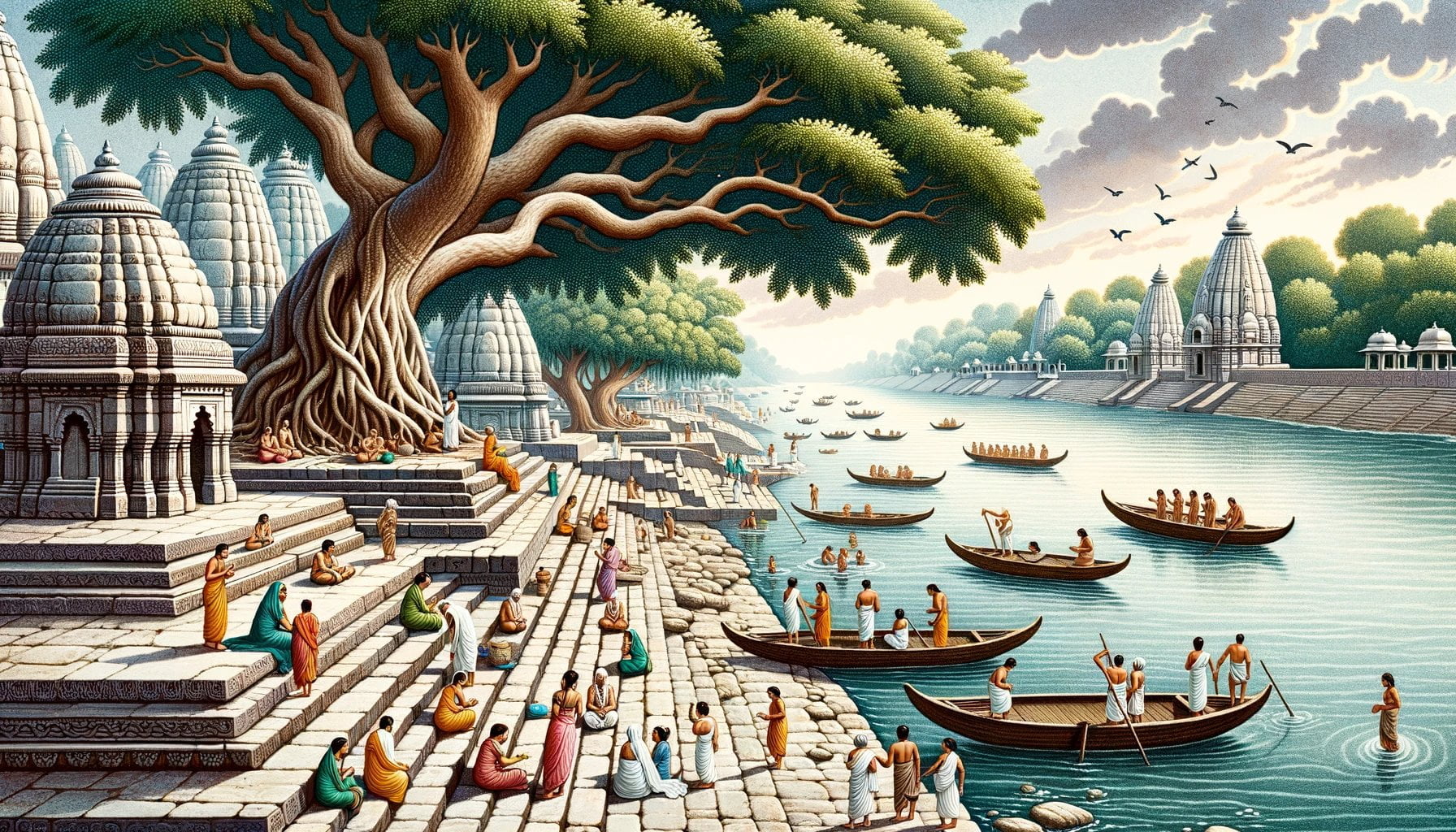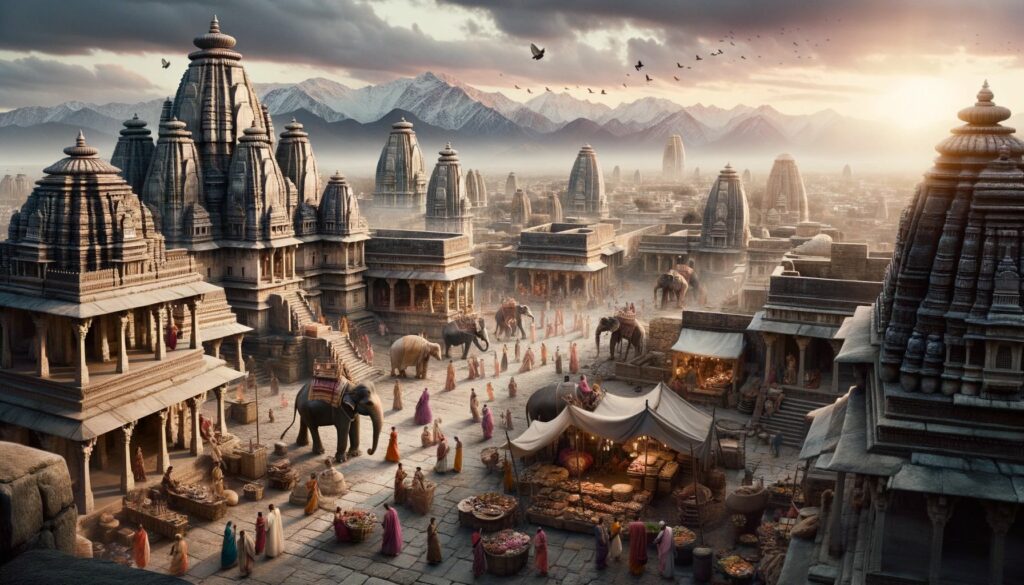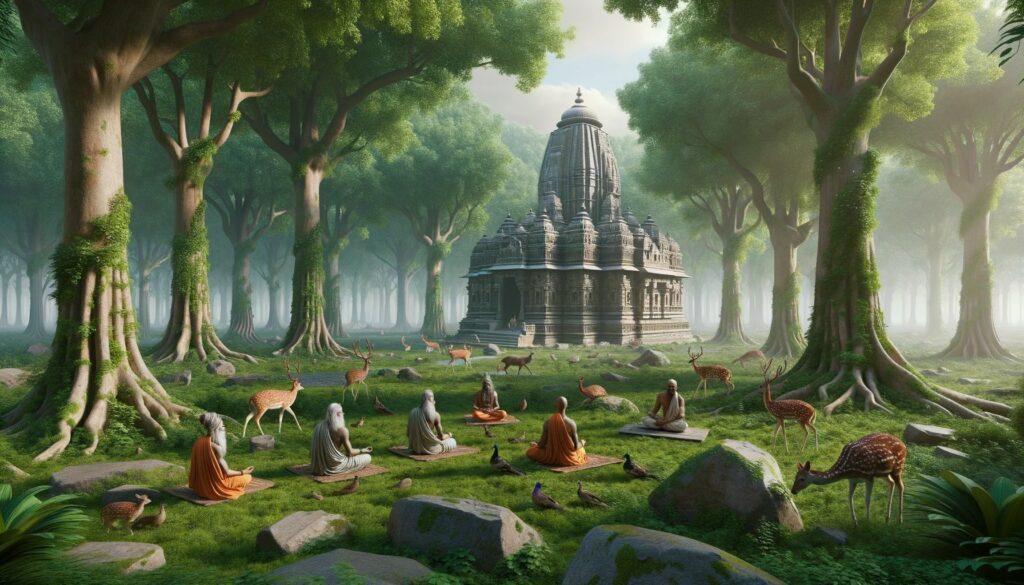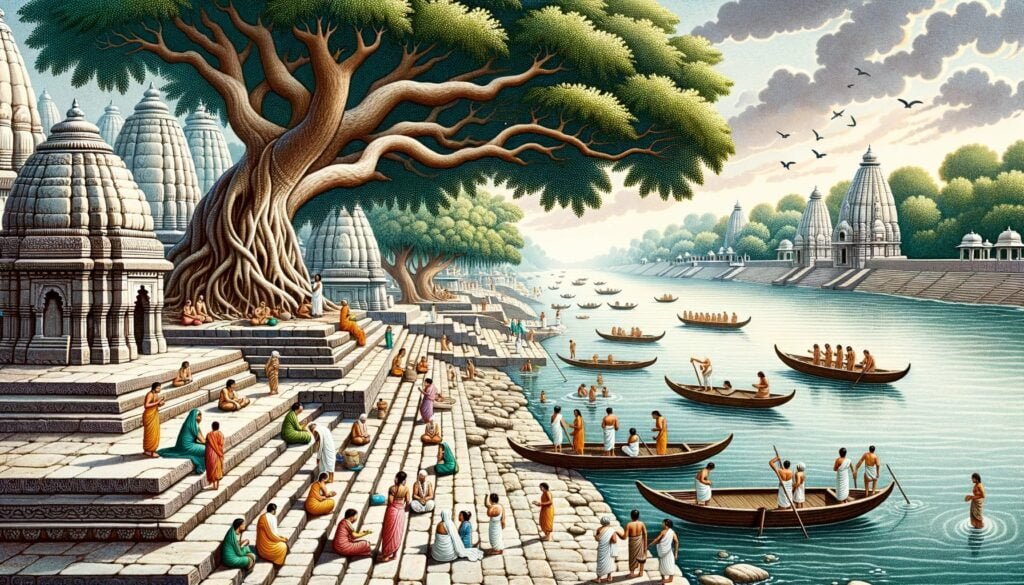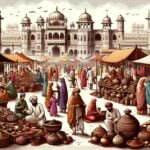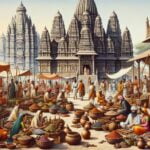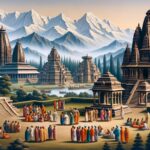Welcome to the captivating world of ancient Indian civilization. In this article, titled “Unveiling the Splendor: Exploring Ancient Indian Civilization,” we will delve into the rich history and culture of this mesmerizing civilization. From the Classical period (c. 200 BCE – c. 650 CE) to its profound contributions in art, science, religion, and philosophy, get ready to embark on a journey through time as we uncover the splendor and significance of ancient India.
Ancient Indian Civilization
As we delve into the depths of history, we uncover the mesmerizing world of the ancient Indian civilization. This rich and diverse civilization, which existed from the 25th century BC to the 17th century BC, holds immense significance in the annals of time. So, let’s embark on a captivating journey through the magnificence of ancient India, exploring its contributions in the fields of science, art, religion, and philosophy.
The Significance of Ancient Indian Civilization
Ancient India was a tapestry of intriguing social, economic, and political structures. One of the defining features of ancient Indian society was the caste system. This rigid system of lifelong social classes, with no social mobility, played a crucial role in shaping the dynamics of the civilization. Each caste had its own set of rights, duties, and occupations, aligning individuals within a hierarchical structure.
But how did ancient Indians sustain their society? Economic organization and trade thrived during this period. Ancient India boasted a robust marketplace where goods and services were exchanged, contributing to the overall prosperity of the civilization. The wealth accumulated through trade bolstered political organizations, allowing rulers to assert their authority and create stable governance structures.
Unraveling the Tapestry of Ancient Beliefs
Religion played a pivotal role in shaping ancient Indian culture. The ancient Indians embraced a diverse range of religions and belief systems, including Hinduism, Buddhism, and Jainism. These faiths were integral to their worldview, influencing their understanding of the universe and the purpose of life.
Imagine a world steeped in the concepts of karma, dharma, and the cycle of life and death. These ideas permeated the ancient Indian psyche, providing a framework for moral conduct and spiritual growth. The belief in karma, the law of cause and effect, shaped their understanding of individual actions and their consequences. Dharma, on the other hand, guided individuals in upholding their duties and responsibilities within society.
Advancements in Science and Technology
Ancient India was a cradle of scientific and technological development. The intellectual curiosity of ancient Indians led to groundbreaking advancements in fields such as mathematics, astronomy, and medicine. Mathematicians like Aryabhata made significant contributions to the understanding of numbers and trigonometry. Astronomers studied the movement of celestial bodies, enabling the development of accurate calendars and astronomical theories.
In the realm of medicine, ancient Indian civilization thrived. Ayurveda, the ancient Indian system of medicine, emphasized holistic healing and the balance of mind, body, and spirit. This ancient wisdom still resonates today, with practices like yoga gaining worldwide recognition for their health benefits.
Cities and Civilization
Ancient India boasted numerous cities, showcasing impressive urban planning and infrastructure. One of the most notable ancient civilizations in India was the Indus Valley Civilization. This advanced society flourished along the banks of the Indus River, and its well-designed cities featured sophisticated sewage and drainage systems, as well as meticulously planned streets and buildings.
Think of these cities as glimpses of a highly organized and prosperous society. The ruins of the ancient cities unearthed by archaeologists reveal the impressive architectural prowess of the ancient Indians.
Enduring Influence
Ancient India had a profound impact on world history, and its achievements continue to wield influence to this day. From the concepts of zero and decimal system, which revolutionized mathematics, to the rich literary tradition of Sanskrit texts, ancient Indian civilization left an indelible mark on human knowledge and cultural heritage.
As we delve deeper into the fascinating tapestry of the ancient Indian civilization, we unravel its splendor and significance. The contributions of this magnificent era in human history continue to inspire awe and admiration. Let us embark on this enchanting journey, uncovering the secrets of ancient India, and celebrating its timeless legacy.
Table: Major Ancient Indian Achievements
| Field | Achievements |
|---|---|
| Mathematics | Concept of zero, decimal system, trigonometry |
| Astronomy | Accurate calendars, astronomical theories |
| Medicine | Ayurveda, holistic healing |
| Architecture | Well-designed cities, sophisticated infrastructure |
| Literature | Rich literary tradition of Sanskrit texts |
As you immerse yourself in this article about ancient Indian civilization, let the echoes of history guide you, and the wonders of this bygone era captivate your imagination. The mesmerizing world of ancient India awaits, ready to unravel its secrets and allure you with its splendor. Embrace this journey, and let the majesty of ancient India leave an indelible mark on your perception of the past.
Ancient Indian civilization holds a fascinating history that has captivated historians and archeologists for centuries. Delving into the depths of time, one may ponder: what is the oldest civilization in India? Unraveling this ancient enigma, it becomes apparent that the Indus Valley Civilization, dating back to around 2500 BCE, takes the crown as the oldest known civilization in India. This thriving society boasted impressive urban planning, advanced drainage systems, and a flourishing trade network. To delve deeper into the wonders of this ancient civilization, click here.
As we explore the annals of time, we begin to question what were the ancient Indian civilizations that paved the way for the rich heritage we see today? The answer lies in the diverse range of ancient Indian civilizations that flourished throughout history. Embark on a journey through time and discover the Indus Valley Civilization, the Vedic Civilization, the Maurya Empire, and so much more. To unlock the secrets of these illustrious civilizations, click here.
Envisioning the grandeur of ancient India, one might wonder just how many civilizations were present during those awe-inspiring times. Surprisingly, India was home to not one, not two, but several significant civilizations throughout its history. From the Indus Valley Civilization to the Gupta Empire, these civilizations shaped the culture, art, and architecture of the Indian subcontinent. To unearth the multitude of civilizations that thrived in ancient India, click here.
Have you ever considered why India claims the title of the oldest civilization? India’s rich cultural heritage and ancient traditions trace back thousands of years, leaving a rich legacy for the world to behold. From the Indus Valley Civilization’s advanced cities to the ancient texts of the Vedas, India has been a cradle of civilization since time immemorial. Embark on a voyage of discovery to unravel the secrets of why India proudly holds the mantle of the oldest civilization. To satisfy your curiosity, click here.
Comparisons between ancient civilizations often bring forth intriguing questions. For instance, is ancient India older than Egypt? While both regions boast ancient roots, India’s civilization predates Egypt’s by thousands of years. Immerse yourself in the fascinating world of ancient history and explore the timelines of these remarkable civilizations. To discover the truth about the age-old rivalry, click here.
Many history enthusiasts wonder whether Greek civilization predates its Indian counterpart. While both civilizations have left indelible marks on the world, ancient Indian civilization predates the Greek civilization by several millennia. Embark on a captivating exploration of ancient history and delve into the unique characteristics of both Indian and Greek civilizations. To uncover the truth and compare these remarkable civilizations, click here.
One may wonder about the various ancient civilizations within the Indian subcontinent. From the Indus Valley Civilization to the Gupta Empire, India has witnessed the rise and fall of many remarkable civilizations. Immerse yourself in the rich tapestry of ancient history and acquaint yourself with the Indus Valley Civilization, the Vedic Civilization, and the Maurya Empire. To embark on a voyage through time and discover the three influential civilizations in India, click here.
As we explore the captivating history of India, we stumble upon the question: what is the oldest name of India? Ancient India has had various names, each reflecting the cultural and historical transformations it has undergone. One of the oldest-known names of India is “Bharatvarsha,” which finds its roots in ancient Hindu mythology. To dive deeper into the enthralling story behind the oldest name of India, click here.
Indian history spans across three distinct periods, each leaving its unique imprint on the pages of time. Curiosity piques as we ask ourselves: what are the three periods of Indian history? Journey through the ages and uncover the answers by exploring the Ancient period, the Medieval period, and the Modern period. To discover the fascinating epochs that shaped the course of Indian history, click here.
Inquisitive minds often question whether Nepal, a neighboring country of India, is older in terms of civilization. However, evidence suggests that ancient India predates Nepal’s civilization by several millennia. Delve into the captivating world of geography and history to uncover the true age of these ancient cultures. To quench your curiosity and explore the chronological timeline, click here.
Classical period (c. 200 BCE – c. 650 CE)
The Classical period in ancient Indian civilization, spanning from around 200 BCE to 650 CE, was an era of tremendous cultural and intellectual growth. During this time, India witnessed remarkable advancements in various fields, including science, art, religion, and philosophy. Let’s delve into this mesmerizing period and unravel the splendor of ancient India.
History: From Empires to Dynasties
The Classical period in India saw the rise and fall of several powerful empires and dynasties. One of the most prominent was the Maurya Empire, established by Chandragupta Maurya in ancient India. However, it eventually collapsed in 185 BCE, giving way to regional powers and dynastic rule. The Gupta Empire, which thrived from the 4th to the 6th centuries CE, marked the pinnacle of this period, characterized by a resurgence of Hindu religion and culture. During this time, Indian civilization, administration, culture, and religion spread beyond its borders, influencing and establishing Indianized kingdoms in various parts of Asia.
Quote: The Classical period witnessed the rise and fall of empires, marking a significant era in Indian history.
Scientific and Cultural Advancements
The classical period of ancient India was marked by remarkable achievements in science, art, and philosophy. Indian mathematics and astronomy made significant contributions that transcended geographical boundaries, greatly influencing the Arab world and even being foundational to the creation of the Hindu-Arabic numeral system. Medicine and surgery also advanced, with ancient Indian physicians developing sophisticated healing practices, such as Ayurveda, which emphasized holistic wellbeing.
Quote: Ancient India’s contributions in science, medicine, and mathematics were truly groundbreaking, shaping the course of history.
Cultural and Religious Diversity
Religious and philosophical movements played a crucial role in shaping ancient Indian civilization during the Classical period. The rise of ascetic movements like Jainism and Buddhism around 600 BCE challenged traditional religious practices and influenced the socio-cultural fabric of the society. The classical period also marked the emergence of Sikhism in the 15th century, further adding to the religious diversity of ancient India.
Quote: Ancient India was a melting pot of diverse religious and philosophical beliefs, giving rise to new ideas and concepts.
Dynastic Struggles and Imperial Powers
The Classical period in India was not without its struggles. The Tripartite struggle, centered around Kannauj, witnessed the rise of multiple imperial powers between the 7th and 11th centuries. Southern India saw the emergence of the mighty Chola dynasty in the 11th century, leaving a lasting impact on the region. Despite invasions and the rise of powerful Hindu states, India remained resilient, showcasing its rich cultural heritage and multifaceted civilization.
Quote: India’s history is a tapestry of dynastic struggles and regional powers, reflecting the resilience of its civilization.
British Rule and Independence
The Classical period eventually gave way to the era of British rule in India, starting with the East India Company. This period witnessed significant political upheavals, culminating in the Indian Rebellion of 1857. India gained independence in 1947, signaling the end of centuries of foreign dominion and the beginning of a new chapter in its history.
Quote: British rule in India marked a turning point in the nation’s history, leading to the ultimate quest for independence.
Conclusion
The Classical period (c. 200 BCE – c. 650 CE) of ancient Indian civilization stands as a testament to the awe-inspiring achievements and cultural richness of this magnificent era. From the rise and fall of empires to the advancements in science, art, and religion, ancient India left an indelible mark on world history. As we explore the splendor of this period, we peer into a captivating journey through time, unlocking the mysteries and significance of ancient India.
Quote: The Classical period of ancient India is a treasure trove of knowledge, waiting to be unveiled and celebrated. Let us embark on this fascinating journey together.
Religion
Religion played a central role in the ancient Indian civilization, shaping the beliefs, rituals, and social fabric of the people. The three major religions of ancient India—Hinduism, Buddhism, and Jainism—left an indelible mark on the region’s history, culture, and philosophy. Let’s delve into these fascinating religious traditions that originated and flourished during this mesmerizing era.
Hinduism: A Tapestry of Beliefs and Rituals
At the heart of the ancient Indian civilization was Hinduism, considered the world’s oldest major religion. It emerged during the Vedic period, characterized by the religious practices of the Indo-Aryans. The sacred hymns and rituals that form the foundation of Hinduism are compiled in the Samhitas, known as the Vedas.
One of the key beliefs in Hinduism is the concept of reincarnation, where individuals undergo multiple births based on their karma, or the consequences of their actions. The ultimate goal is to attain liberation from this cycle of rebirth and achieve an enlightened state, known as moksha. This pursuit of liberation and self-realization is deeply intertwined with rituals, such as meditation, yoga, and devotion to deities.
Quote:
Hinduism, with its rich tapestry of beliefs and rituals, permeated every aspect of ancient Indian life. From daily practices to grand ceremonies, it offered guidance and spiritual solace to millions.
Buddhism: The Path to Enlightenment
Buddhism, founded by Gautama Buddha in the 6th century BCE, originated as a reform movement within Hinduism. It challenged the prevailing social and religious norms, emphasizing the individual’s quest for salvation and the eradication of suffering. Buddhism sought to liberate individuals from the cycle of rebirth through the attainment of nirvana, a state of complete enlightenment.
Key principles of Buddhism, such as the Four Noble Truths and the Eightfold Path, guided followers on the path to self-realization. The Middle Way, a philosophy that advocated for a moderate approach to life, resonated deeply with the people of ancient India.
Quote:
Buddhism, with its profound teachings and emphasis on personal enlightenment, captured the hearts and minds of many individuals, offering an alternative spiritual path in ancient India.
Jainism: The Path of Non-Violence
Jainism, emerging around the same time as Buddhism, was another significant religious tradition in ancient India. Founded by Mahavira, Jainism emphasized non-violence (ahimsa) and compassion towards all living beings.
Jainism rejected the authority of the Vedas and emphasized a path of self-discipline and detachment from material possessions. Its followers, known as Jains, practiced strict vegetarianism and undertook ascetic practices to purify their souls and attain spiritual liberation.
Quote:
Jainism, with its unwavering commitment to non-violence and spiritual purity, left a lasting impact on ancient Indian society, inspiring individuals to adopt a lifestyle of compassion and self-restraint.
In conclusion, religion served as a guiding light in the ancient Indian civilization, shaping the lives, beliefs, and practices of millions. Hinduism, Buddhism, and Jainism provided frameworks for spiritual growth, enlightenment, and moral conduct. These religious traditions not only influenced the lives of individuals but also left an enduring legacy on the art, literature, and philosophy of ancient India.
Note: Feel free to add relevant images or tables to enhance the article’s visual appeal and provide additional information for the readers.
Ancient India was a land of remarkable achievements, and one area that stands out is its achievements in art and architecture. From intricately carved temples to magnificent sculptures, the artistic prowess of ancient Indians is truly captivating. In fact, you can explore more about these awe-inspiring achievements in ancient India by visiting Lola App’s page on Ancient India Achievements.
So, what made artistic endeavors in ancient India truly remarkable? Experience the exquisite beauty of ancient Indian art and architecture firsthand by clicking this link: Ancient India Achievements. Prepare to be amazed as you delve into the intricate details and rich cultural heritage that this remarkable era has to offer.
Moving on to another aspect that showcases the brilliance of ancient India, let’s talk about its achievements in science and technology. The ancient Indians made significant contributions in various fields such as mathematics, astronomy, and medicine. Explore the fascinating world of ancient Indian scientific achievements by clicking this link: Ancient India Achievements. Discover how ancient Indians laid the foundation for numerous scientific principles that we still rely on today.
Continuing our journey into the remarkable history of ancient India, let’s discuss its contributions to philosophy and spirituality. Ancient Indian philosophy encompasses a diverse range of schools of thought, each with its unique insights and profound wisdom. Delve into the depths of ancient Indian philosophical traditions by clicking this link: Ancient India Achievements. Prepare to expand your understanding of life, existence, and the pursuit of ultimate truths.
The achievements of ancient India are boundless, and there is so much more to discover. From its literature to its medicine, ancient India leaves a lasting impression on every aspect of human civilization. Satiate your curiosity and embark on a journey through the cultural marvels of ancient India by clicking this link: Ancient India Achievements.
Remember, each click brings you one step closer to unraveling the secrets of a bygone era and gaining a newfound appreciation for the accomplishments of our ancestors. Prepare to be inspired and captivated by the brilliance of ancient India. Happy exploring!
FAQ
Q: When did the ancient Indian civilization exist?
A: The ancient Indian civilization existed from the 25th century BC to the 17th century BC.
Q: What was the social organization in ancient India?
A: Ancient Indian society was organized based on a caste system, with closed lifelong social classes and no social mobility.
Q: Was there economic organization and trade in ancient India?
A: Yes, economic organization and trade were prevalent in ancient India.
Q: What was the political organization in ancient India like?
A: Political organization in ancient India was an important aspect of its civilization.
Q: How did religion influence ancient Indian culture?
A: Religion played a significant role in ancient Indian culture, with various religions and belief systems.
- Sept 31 Myth: Unveiling Calendar Secrets - March 18, 2025
- How Long & Till December 18, 2025: Accurate Countdown Guide - March 18, 2025
- Discover Japanese Artists: A Complete History - March 18, 2025
